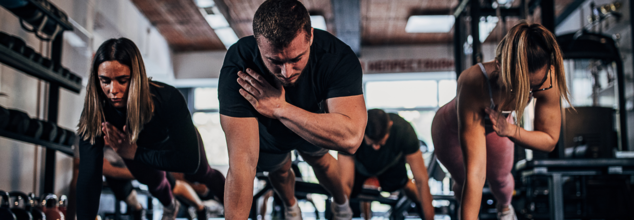- Health Conditions A-Z
- Health & Wellness
- Nutrition
- Fitness
- Health News
- Ayurveda
- Videos
- Medicine A-Z
- Parenting
- Web Stories
4 Rugby Workout For All-Round Fitness

(Credit-Canva)
We can all sit in front of our TVs and claim that we can do what the professionals athletes do, but these people train every day to achieve their specific skillset. Elite rugby players are incredibly fit, both mentally and physically. Rugby is a very intense and aggressive game where the players must endure intense collisions and maintain high levels of endurance throughout long matches. This means that instead of the short burst of energy and strength, they must make sure their energy levels stay even, so that they don’t exhaust themselves too early. This level of fitness does not come by easily, in fact you must dedicatedly train in the gym and focus on building a strong foundation. Their workouts can also help people who do not wish to play rugby, you can do these exercises if you wish to improve your strength and conditioning. Strength and speed play a very important role in rugby, hence you must focus on explosive and dynamic movements
Role of Conditioning For Rugby Workout
Rugby training in the gym focuses on full-body, sport-specific movements rather than isolated muscle exercises. Workouts are typically short, around an hour, and include dynamic lifts, compound exercises like squats and deadlifts, and accessory work for core and hip stability. Conditioning sessions involve short, high-intensity intervals on equipment like assault bikes, simulating the demands of a rugby match. The focus is always on training movements, not just muscles.
Workout 1: Explosive Strength + Core Stability
This workout is all about building strong muscles and a stable core. You'll start with power cleans, which help you develop explosive power. Then, you'll do squats to strengthen your legs and glutes. Landmine presses work your shoulders and core, and single-arm rows build your back muscles. To finish, a core circuit will strengthen your abs and lower back. This circuit includes exercises like Copenhagen planks, hip thrusts, and various plank variations. These exercises improve your balance and stability, which are important for both sports and everyday activities. Remember to focus on good form and controlled movements to avoid injuries.
Workout 2: Aerobic Conditioning
This workout focuses on improving your aerobic fitness, which is your body's ability to use oxygen during exercise. You'll be using an assault bike for high-intensity intervals. This means you'll cycle hard for short periods and then rest. These intervals help your heart and lungs get stronger. The goal is to push yourself to a high level of effort during the work periods. You should feel your heart rate increase significantly. This type of training helps you build endurance and improve your overall cardiovascular health. Don’t worry about distance, focus on how hard you are working.
Workout 3: Explosive Strength + Bodybuilding
This workout combines explosive movements with exercises that build muscle mass. You'll start with jump squats to develop explosive leg power. Then, you'll do box step-ups and split squat jumps to further strengthen your legs and improve balance. Bench presses and pull-ups will work your chest, back, and arms. Finally, a bodybuilding-style accessory circuit will help build muscle in smaller muscle groups. This circuit includes exercises like dumbbell hammer curls, dips, lateral raises, and upright rows. Building muscle mass helps protect your joints and improves your overall strength. Remember to use a weight that challenges you while maintaining good form.
Workout 4: Anaerobic Conditioning
This workout is designed to improve your anaerobic fitness, which is your body's ability to perform high-intensity activities for short periods. You'll be doing short, high-intensity sprints on an assault bike or Wattbike. These sprints are very intense and will push your body to its limits. You’ll work for six second bursts, then have a short rest, and repeat. Between rounds, you'll perform active recovery exercises to keep your body moving and help it recover. These exercises include light footwork drills or other movements that target different muscle groups. This type of training helps you build speed and power, which are important for many sports and activities.
Does Your Metabolism Really Slow Down With Age? Here Is The Truth

We have all heard the elders saying it is harder to lose weight after 40 because your metabolism slows down. But is that really the case, or are we blaming something that is not even responsible? Fitness expert Jaymie Moran took to Instagram to break down what actually happens as we age, and his take might surprise you.
Your Metabolism Does Not Suddenly Tank at 40
Referencing a major 2021 study led by Duke University researchers that tracked 6,400 people ranging from infants to 95-year-olds, Moran mentions the study’s striking discovery: metabolism stays remarkably stable between the ages of 20 and 60.
“There is no magical slowdown and no flip that gets switched as soon as you turn 40,” Moran states. So if that is the case, why does managing weight suddenly feel so much harder?
It is Not Your Metabolism; It is Your Life
“Well, you are probably not going to like the answer,” Moran warns, “but we are here to cut the BS.” According to him, it is not about your metabolism at all; “It is your life.”
Moran explains how our lifestyle in our 40s looks vastly different from our younger years. “You are sleeping one or two hours less than you did in your 20s. You are sitting at a desk for eight or nine hours a day. Your active hobbies have turned into running the kids round or scrolling on Instagram in bed.”
And the main issue? Stress. “You are stressed out, never feel like you have any time, and are grabbing convenient crap that you probably would not have touched a decade ago.”
Hormonal Issues Add to the Chaos
“And let us not forget about perimenopause knocking on the door,” Moran adds, “which does change how your body stores fat, especially around your midsection.”
He points out that night sweats wreak havoc on your sleep, which in turn “absolutely screw with your hunger and fullness hormones”. As your hormones shift, you end up “moving less because you are exhausted, and you are probably eating more.” According to Moran, that is why the scale creeps up, not because your metabolism has suddenly failed you.
Same Old Strategy, Different Body and Life
Moran says the real problem is trying to apply the same health and fitness approach from your 20s, even though everything about your life and body has changed. “You are still trying to follow the same approach that you used in your 20s, even though your body and your life are very different now.” However, he says that weight loss and getting your health in check is still completely possible.
Smarter Strategy for a Smarter Body
According to Moran, you just have to adjust your strategy. His recommendations are clear:
- “Prioritise protein and fibre to maintain your muscle and control hunger.”
- “Get seven to eight hours of quality sleep. Your hormones will thank you.”
- “If you struggle with night sweats or you get too hot, buy a cooling mattress. It will literally change your life.”
- “Strength train two to three times a week for 30 to 60 minutes. This is a non-negotiable if you want to age strong.”
- “Walk more. You have got to be doing at least 8,000 steps a day.”
If 8,000 sounds like a stretch, Moran has a simple plan: “If you are at 4,000 or 5,000, start adding 1,000 a month on until you get to 8,000 and just make it part of your daily routine.”
It is About More Than the Scale
Moran ends with a powerful reminder: “This is not just about the number on the scale. This is about your energy, your strength, your confidence, your independence, your self-esteem, and staying capable.”
6 Wrestling-Inspired Workouts That Build Strength and Stamina

If you were into Trump cards growing up, we get why wrestling holds a special place in your heart. It does not matter if you were actually wrestling with your friends, watching the pros throw down on screen, or signing up for every similar sport in school; wrestling was everywhere. And now, Hulk Hogan’s passing has come as a shock to many. The man who defined professional wrestling and became a full-blown pop culture icon in the 1980s reportedly died of cardiac arrest at the age of 71.
Confirming the news, the World Wrestling Federation (WWE) said they were deeply saddened to learn of the death of Hogan, real name Terry Bollea. From Donald Trump to Dwayne “The Rock” Johnson, tributes poured in on social media, honouring the WWE Hall of Famer. Hogan was a larger-than-life hero through the ’90s, and nothing brought more joy than those flashy WWE cards as a kid.
Beyond Hogan’s unbeatable charisma and how effortless he made the sport look, wrestling has always stood for strength, stamina, and power. It was never just about winning; it was about how massive and intimidating you looked doing it. And the bigger and more muscled up you were, the stronger you seemed. Or at least, that is what we grew up believing.
But you are not alone in thinking that. And real strength comes from real training. So wrestling may not be everyone’s cup of tea, but strength training is for everyone. Here are six exercises that channel the intensity of wrestling. Do them at home, at the gym, or wherever you feel most pumped.
1. Rope Slams
Rope slams build upper body strength, torch calories, and improve grip, something wrestlers swear by. Five minutes in, your arms will burn, your heart will race, and you will realise this is not just cardio.
2. Sandbag Carries
Wrestlers need raw power and real-world strength, not just pretty muscles. Carrying a sandbag across distances mimics holding and lifting a resisting opponent. It strengthens your back, core, arms, and legs, all while making you feel like a total tank.
3. Sled Pushes
Sled pushes mimic the kind of explosive force wrestlers use in takedowns. You are pushing weight while keeping low, just like you would drive into an opponent. Great for legs, lungs, and pure willpower. You will love how destroyed and strong you feel at the same time.
4. Grappling Drills
Whether it is rolling, clinching, or ground control, grappling builds real functional strength and serious stamina. These drills develop coordination, core power, and body awareness, basically your full-body IQ. Plus, they toughen your mind. Wrestlers do not just train to win; they train to outlast, and this is where it starts.
5. Bulgarian Split Squats
They challenge balance, coordination, and leg strength all at once. The deep stretch and burn translate to explosive takedowns and stronger stances. Hate them or love them, they deliver serious results, especially when your legs feel like jelly halfway through.
6. Battle Crawls (Low Crawls)
You are on the floor, elbows and knees digging in, dragging your body forward. This brutal crawl mimics wrestling scrambles and builds total-body resilience. It hits your core, shoulders, and quads like few other moves.
Daily Yoga Could Cut Diabetes By 40%, Says New Study

Credits: Canva
Yoga might be more than a wellness trend or a stress-busting tool. A new study titled “Yoga and Prevention of Type 2 Diabetes”, published by the Research Society for the Study of Diabetes in India (RSSDI), has found that regular yoga practice can reduce the risk of developing type 2 diabetes by up to 40%—especially in individuals already predisposed due to factors such as obesity, family history, or a sedentary lifestyle.
The findings were recently presented to the Union Health Minister and are among the first to explore yoga’s preventive role in diabetes, moving beyond earlier research that largely focused on managing blood sugar in people who already have the disease. The study was led by renowned endocrinologist Dr SV Madhu, whose team focused on high-risk groups to examine yoga’s long-term effects on metabolic health.
Can Yoga Prevent Diabetes?
While previous studies examined how yoga helped manage diabetes, this research pivots to a vital question: Can yoga help prevent it altogether? The answer appears promising.
The researchers assessed participants who were at high risk for developing type 2 diabetes—those with insulin resistance, a family history of diabetes, or unhealthy lifestyle indicators like poor diet and lack of physical activity. Over the course of the study, individuals who practiced yoga consistently showed noticeable improvements in:
- Fasting blood sugar levels
- Insulin sensitivity
- Waist circumference and BMI
- Stress and cortisol levels
- Overall metabolic balance
The combined impact of movement, mindful breathing, and meditation, the study notes, contributes to a more regulated stress response system—a key factor in maintaining stable insulin and glucose levels.
How Does Yoga Help?
Yoga activates the parasympathetic nervous system, also known as the body’s "rest and digest" mode. This downregulates stress hormones like cortisol, which, when chronically high, are known to spike blood sugar and reduce insulin sensitivity.
Additionally, certain yoga poses stimulate abdominal organs such as the pancreas and liver, both central to metabolic regulation. Stretching, twisting, and deep breathing help improve digestion, circulation, and hormonal balance, all of which play a critical role in metabolic disease prevention.
5 Yoga Poses That May Support Diabetes Prevention
If you’re looking to incorporate yoga into your routine with prevention in mind, here are five asanas the study recommends:
Trikonasana (Triangle Pose):
This standing posture improves digestion and opens the body’s side lines. Its gentle twisting action massages the abdominal organs and supports better metabolism.
Bhujangasana (Cobra Pose):
A heart-opener and back-strengthener, this pose stretches the abdomen and stimulates the pancreas. It’s great for reducing spinal tension and post-meal sluggishness.
Paschimottanasana (Seated Forward Bend):
Though it looks simple, this calming pose eases stress and stimulates the internal organs. Over time, it may help improve insulin sensitivity.
Dhanurasana (Bow Pose):
In this energizing posture, lifting both upper and lower body activates core muscles and stimulates the pancreas. It also enhances circulation and is a great addition to morning routines.
Ardha Matsyendrasana (Half Spinal Twist):
This classic seated twist supports liver detoxification, improves digestion, and balances hormones—important factors in diabetes prevention.
© 2024 Bennett, Coleman & Company Limited



